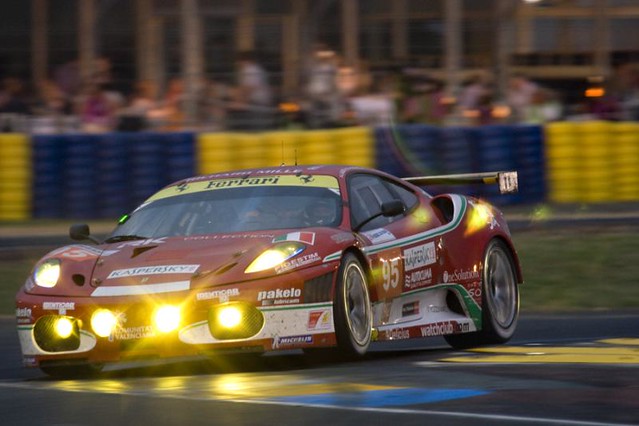As the saying goes, "You can't tell the horses without a program," so every year, I like to give a little bit of a background on the race - who to watch, what to look for, and some personal opinions and observations thrown in for color.
So what should you look for? Check out the class listings below. We'll even do a race recap on Monday, so stay tuned.
LMP1 (LeMans Prototype 1 - the big, fast cars)
Once again, it's the classic AUDI/Peugeot matchup for the overall win. Both teams are running diesel engines which have proven to be fast and easy on fuel consumption. Of special note is the introduction of the new AUDI R18, which is a closed-cockpit car (which is a switch from many previous years of open-cockpit AUDIs). This means the tires are narrower, but the new roof (and ungainly trailing dorsal fin) should mean higher speeds and stability along the two long straights at LeMans. As always, we'll be cheering for Tom Kristensen, the most winningest driver in LeMans history. Currently, AUDI holds the #1 and #2 spots, with Kristensen's car in fifth, with Peugeot 908s all around.
Diesel should be an interesting race this year, since the top seven cars are all within 1/2 second of each other.
Henri Pescarolo has come close to an overall win a few times in the past, and his team is always hungry for a win, even after some real heart-breaking finishes. Unfortunately, they've switched to a gasoline-powered engine this year, and will start the race in 9th, nearly eight seconds per lap slower than the pole-sitting AUDI. The Toyota-powered Lolas of the Rebellion Racing team should have an interesting battle all their own with the Pescarolo team, and are on the grid in 8th and 10th place. Unfortunately for the factory Aston Martins, they only managed to qualify in 22nd and 25th positions (20+ seconds per lap slower than the pole-sitting AUDI), so they will not pose a serious threat this year.
LMP2 (smaller, lighter, but less powerful versions of LMP1)
LMP2 typically plays second fiddle (usually third or fourth fiddle) to the rest of the race. The teams keep making them faster, but due to the class rules, the cars end up being tremendously handicapped. In smaller races, LMP2 cars have been known to score an outright win over the faster LMP1 class, but not at LeMans. This, incidentally, is why Roger Penske's Porsche RS Spyders (that dominated the ALMS series) never participated at LeMans. The team was invited, but he declined out of protest since the P2 class was hobbled so much that an overall win wouldn't be possible.
Nevertheless, if the French TV feed decides to show some LMP2 action, enjoy it like you would a rare delicacy. All the cars seem to be within a second of each other, respectively, so it could come down to tire and fuel management to decide the class winner.
LM GTE
This year marks the first year of the LM GTE classes, which are retain 95% of the rules for the class previously known as GT2 (there is no longer a GT1 class). The vehicles are based on road-going cars and must have gasoline engines only. The minimum production number is 100 copies for major manufacturers (25 for small ones), and use an engine of which a minumum of 300 have been made. Cars with carbon chassis are allowed as long as there are a minimum of 300 produced. Engines have to remain in their same location, and supercharged engines have air restrictors.
The end result should be a great "run what you brung" series, with the likes of such enthusiast favorites as the Corvette ZR-1, BMW M3, and Porsche 911 RSR battling with newcomers like the Ferrari 458, Lotus Evora and even an Aston Martin Vantage and a Ford GT.
One of the intriguing things that has been added is the split of the LM GTE class into "PRO" and "AM" classes. The PRO class allows for three professional drivers to pilot each car, while "AM" only allows for one professional driver per car, with the other two being amateurs. Between the driving and the factory money in the PRO class, it should quickly become a game of the "haves" versus the "have nots".
Nevertheless, the ones to watch should be the duels between the Corvette Racing ZR-1s against the BMW Motorsports M3s. The Bimmers set the class lead, with the lead car being nearly 2 seconds per lap faster than both Corvettes. Also keep an eye on the silver/red Porsche 911 RSR of the Flying Lizard team, a particularly talented and fast crew, that is currently 12th in class.
The real X-factors in the LM GTE class are the new Ferrari 458s. Although a PRO team has one sitting 2nd in class at the moment with a blistering speed not far off the lead BMWs, fuel management and reliability could either put the cars out front, or bench them one by one. To no one's surprise, the Lotus Evoras are in dead last, and third from dead last.
Enjoy the show - I know I will!
AUDI R18 (LMP1 class pole position)
Photo from lemans.org
Signatech Nissan Oreca (LMP2 pole position)
Photo from ototweet.com
BMW Motosport M3 GT (LM GTE Pro pole position)
Photo from bwmblog.com
AF Corse SRL Ferrari 430 Competizione (LM GTE AM pole position)
Photo from Andrew Goldstraw on Flikr
.



